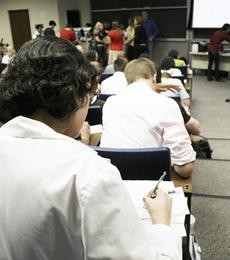Imagine the desert as a pharmacy, the land as a giant grocery store. Traditional Indian Medicine goes beyond science and turns to nature, body, mind and spirit for healing.
The concepts and potential role in society of Traditional Indian Medicine (TIM) were discussed at a one-day conference in the DuVal Auditorium of the Arizona Health Sciences Center on April 18.
“”That’s the beauty of healing, incorporating a person’s mind, spirit and connection with the Creator,”” said Carlos R. Gonzales, an associate professor of clinical family and community medicine at the UA College of Medicine. “”The healer, or medicine person, is always patient. The healer will give ceremonies, medicines and herbs, but all we do is facilitate the healing process; a person has to heal themselves.””
According to TIM teachings, the ultimate power of healing is within oneself.
“”We approach our patients with unconditional love, always,”” Gonzales said. “”According to my teaching, love is life. In order for us to live well, we need to love unconditionally. If a person does not love themselves, or appreciate themselves, then how can they be healed?””
Gonzales said another difference between western medicine and TIM is the relationship held between the doctor and the patient. When using TIM, the patient is just as active in the healing process as the doctor, he said.
“”Illness is an experience,”” Gonzales said. “”The patient needs to learn how to avoid this from happening again, what they did to end up there and how to do it better next time. Every illness teaches a lesson.””
TIM also believes there are no such things as accidents.
“”Accidents are spirits talking to you, telling you to wake up. They are trying to tell you what you’re doing wrong,”” Gonzales said. “”Harmony is the ultimate goal and wellness is a balance and harmony in one’s life – a disease is exactly that, a state of dis-ease. There’s something going wrong, and you need to look at the body, mind and spirit to get well.””
Johnson Dennison, coordinator of the office of Native Medicine at Chinle Comprehensive Health Care Facility, in Chinle, Ariz., also spoke at the conference.
“”All will be beautiful, all will be praised in harmony,”” said Dennison, who has been a medicine man for 35 years. “”When we see a patient, we don’t say bad things. We don’t say anything negative – we approach with love. We want to increase the number of patients using this healing.””
Dennison, as well as the other speakers at the conference, said they are trying to increase traditional services for patients.
Herbs are as effective for healing today as they were thousands of years ago, said Lane Johnson, an associate professor of clinical and family and community medicine. Although we may live in a different society, the human body has not changed.
“”Let’s stop for a second and think that this is 400 years ago””, said Johnson, who is also author of the book “”Pocket Guide to Herbal Remedies.”” “”To think that we don’t need to go to the store to buy everything, everything is already here – that is a true joy.””
Johnson said he is very familiar with the herb Opuntias, which was used in a study for type two diabetes.
“”Plants can be powerful, but can also harm,”” Johnson said. “”They can help reduce certain cancers, but some may induce. That’s why collaboration in medicine is important.””
The auditorium was filled with physicians, professors, families and students, as the speakers each gave their own perspective on the differences between TIM and western medicine and how collaborating may serve as a better way of healing.
“”It’s all about how you think – how you appreciate the life given to you. If you have a better appreciation of self, it will be expressed and radiated in the business world. It’s acceptance rather than resolve,”” Johnson said.
When someone from the audience asked how they could know if TIM is successful, another member of the audience went to the microphone and answered.
“”Sometimes you just have to have faith,”” said Jennie R. Joe, a professor in family and community medicine and director of Native American Research and Training Center. “”It’s really an internal mechanism. You are the medicine; the power of the medicine is in you. We always look for outside healing, but it’s us.””









